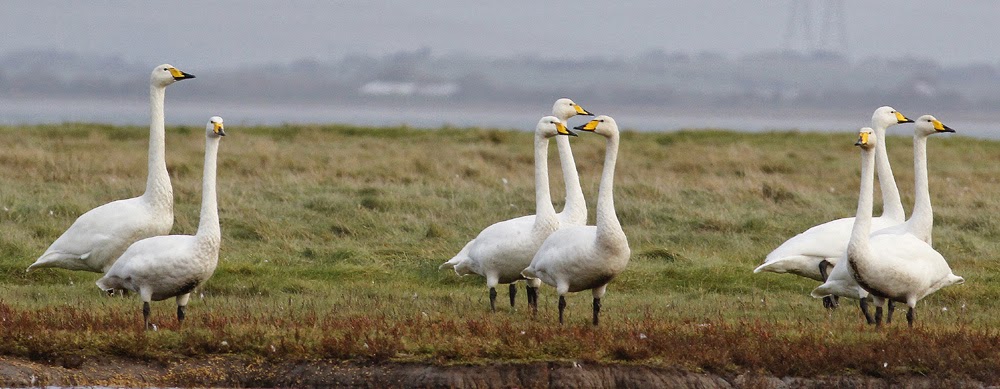Friday dawned grey and breezy with the threat of rain. So I took a leisurely tea and toast as an hour or more elapsed before the sky brightened and motivation kicked in. I set out for a walk at Pilling - Fluke Hall to Pilling Water along the sea wall and shore, then back via the woodland.
Two Ravens croaked across the marsh and headed in the general direction of Lane Ends, and as I scanned east I noted 14+ Little Egrets and a single Grey Heron scattered at suitable intervals both on the marsh and just inland. Although the species roosts communally, a single Little Egret will vigorously defend a quite small feeding territory.
I was late as most of the Whooper Swans had set off inland where up to 200 have been feeding on flooded fields near Eagland Hill, the inland hamlet all of 33ft above sea level. I was left with just 8 Whoopers to consider.
Whooper Swans
The 11am tide was running in and producing some good flights of birds. Many were too distant to bother with in the grey light and stiff breeze but I had good counts of 29 Snipe, 23 Black-tailed Godwit, 60+ Shelduck, many hundreds of Wigeon and dozens of Pintail.
Black-tailed Godwits
Out of the corner of my eye I spotted a bird fly low along a flooded ditch, thought it might be a Green Sandpiper but as it turned and flew along the main channel and lost to view I could see it was the local Kingfisher.
The tide was moving passerines, mostly Skylarks but also 50+ Linnets and several Reed Buntings, the Reed Buntings flying into the cover given by wildfowlers’ maize. Adding the Skylarks shifted by the tide to those already feeding on the wet stubble field I reached a total of 60+ individuals.
Reed Bunting
The wind increased, the grey persisted so I headed for the relative calm of Fluke Hall, pausing to watch Redshanks, Snipe and Lapwings rise from the flooded field.
Lapwings
At Fluke was the resident Kestrel pair, a single Buzzard, 1 Mistle Thrush, 1 Great-spotted Woodpecker, 2 Jays, and several newly arrived Blackbirds, the thrushes feeding quietly in the hawthorn hedgerow alongside a few Tree Sparrows
Saturday, and after a rather dismal week apart from Wednesday morning which provided a ringing session in the hills at Oakenclough I went back there this morning. It was time to top-up the feeders and weigh up what’s about in readiness for mid-week ringing if the weather improves.
Driving across the moss roads of Stalmine, Pilling and Winmarleigh I clocked up an early Barn Owl, 4 Whooper Swans, 3 Buzzards and 2 Kestrels, and then beyond Garstang another Buzzard feeding in a stubble field.
The feeding station seemed a little quiet with seemingly not as many birds around as in the week but a good mix of titmice, a few Goldfinches, Chaffinches and Bullfinches plus a Mistle Thrush. Otherwise - 90 Lapwings, Great-spotted Woodpecker, 2 Kestrel.
Feeding station
Mistle Thrush
Looking to the south-west I could see Saturday’s rain arriving so headed home to greet the deluge.
Stay tuned. There’s more soon from Another Bird Blog.
In the meantime I'm linking to Anni's blog and Eileen's Saturday Blog.














































































